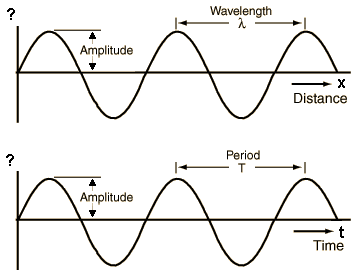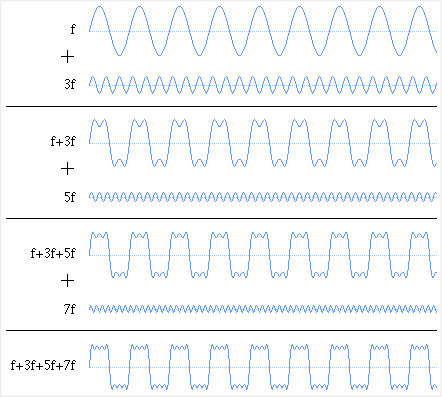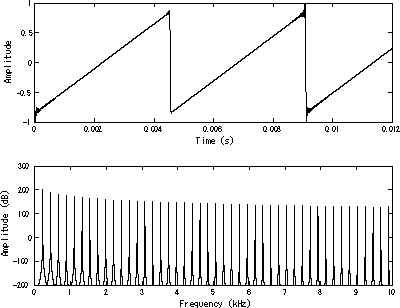The Basics of Synthesis
Sound synthesis is achieved by generating waveforms and manipulating the resulting sounds. The process of sound synthesis begins with the use of a waveform generator, called an oscillator. The oscillator creates a sound wave, the most basic of which being a a sine wave. This wave consists of a fundamental frequency, with zero harmonic overtones. An example would be a sine wave of the note A, which would have a fundamental frequency of 110Hz.
This is a screenshot of a frequency analyzer showing the note C3. The first peak is at 130.81Hz, representing the frequency of C3. The following peaks represent the overtones of the note being played.
At it's most basic, subtractive synthesis is the process of generating sound waves with an oscillator, before using filters to mould those waves into a desired sound.
The main elements of sound are:
Frequency - The rate at which the wave cycle repeats per second. Dictates what musical pitch and note a sound is. Higher frequency sounds are heard as higher pitched than low frequency sounds
Wavelength - The distance between two crests in a wave
Amplitude - The maximum point of displacement from the zero value on a wave. In sound, this relates to volume.
Period - The time it takes a wave to complete a full cycle.
Other elements of sound that are important in subtractive synthesis involve the variations in volume throughout the duration of a sound, or in the case of a synthesiser; the changes in volume of a note following a key being pressed. This is referred to as envelope and includes:
Attack – Time taken for a note to reach it’s maximum amplitude
Decay – Time taken between attack and sustain level
Sustain – Level of amplitude after the decay stage and until the key is released
Release – Time taken for the volume to reach zero from the sustain level.
Relating
subtractive synthesis to acoustic theory
The subtractive synthesis process begins with the use of a waveform generator, called an oscillator. The oscillator creates a sound wave that can be altered.
The shape of this sound wave (or waveform) can be adjusted to better suit the desired sound. Frequency can be controlled; usually through a keyboard. An amplifier controls the overall volume as well as the ADSR.
The shape of this sound wave (or waveform) can be adjusted to better suit the desired sound. Frequency can be controlled; usually through a keyboard. An amplifier controls the overall volume as well as the ADSR.
Waveform
can also be changed on an oscillator, with a number of shapes to choose from,
including:
Sine
- The simplest waveform. Sine is a simple wave with a smooth,
pure toned sound. The sine wave consists only of a fundamental frequency. Additional
sine waves added above the fundamental frequency are called harmonics, and
would turn the sine wave into a different wave shape, as a pure sine wave
has no extra harmonics above the fundamental frequency. Sine waves sound similar to pure sounds such as whistles.
Square
- Square waves are formed by adding additional harmonics
above the fundamental in odd intervals (1, 3, 5...). An ideal square wave would
consist of infinite odd harmonics above the fundamental, so more harmonics
added above the fundamental would bring the waveform closer to it's ideal
state. Square wave signals pulse sharply on and off (the signal rapidly
switches between a positive signal of it's maximum amplitude and an equal but
negative signal) due to the shape having steep edges, making
them useful for pulse width modulation. Square waves sound
less buzzy than saw, and are a good place to start when replicating wind
instruments as they have a more ‘hollow’ sound.
Here is a sound that I created using the square waveform on Logic 9's ES2 synthesizer. In my opinion, this sound resembles the sound of a flute. This is an example of how square waves give a hollow sound.
Sawtooth - Saw waves are
formed by sine waves added with the formula: 1/fundamental. For example the
first harmonic would be 1/1 = 1, second would be 1/2 (half the level of the
first) and the third would be 1/3 (a third of the level). This
wave sounds a bit more gritty and distorted than sine, and due to it's harmonics, is useful when trying to replicate the sound of brass instruments.
Triangle Like
square waves, the harmonics of triangle waves increase in odd increments,
however, the harmonics in a triangle wave progress as follows: 1, 1/(3^2),
1/(5^2)Triangle waves have a sound which lies somewhere between sine and
sawtooth, and can be made to sound like pads or even vocals.
Another important component in subtractive synthesizers is the low frequency oscillator (or LFO). The LFO produces a low frequency wave which can then be programmed to control different parameters. For example, an LFO can be programmed on a matrix (interface used to program synth modules) to modulate the filter cut off, meaning that a filter's cutoff point is constantly changing according to the amplitude of the wave being produced by the LFO.
Filters
Once a wave has been created, filters are used to shape the timbre of the sound. They do this by removing or amplifying specific frequencies. There are several different types of filter:
Lowpass filter - Removes or lowers high frequencies while allowing lower frequencies to pass. A cutoff point is set, and any frequency above this point is lowered by the filter.
Highpass filter - Removes or attenuates lower frequencies and allows higher frequencies to pass. A cutoff point is set, and any frequency below this point is lowered by the filter.
Band pass filter - Allow frequencies within a certain frequency range to pass, while lowering or removing all others
Band reject filter - Lowers or removes frequencies from a certain range
Many filters have an option for resonance. Increasing resonance will boost the frequencies just before the cutoff point, giving an effect sounding similar to phase.
Virtual vs Analog
Analog synthesizers differ to digital synths in that the modules that they are comprised of are controlled by voltage. The VCO (voltage controlled oscillator) generates a signal (a waveform). The VCF (voltage controlled filter) is then used to sculpt this waveform by removing unwanted frequencies. The overall volume of the sound, as well as the ADSR can then be modified using the VCA (voltage controlled amplifier). In an analog synth, this continuous signal flows throughout the system.
In a virtual synth, mathematical algorithms are used to try to imitate the circuitry of analog synths. This has it's limitations, as digital signals run on binary signals, which are limited in their resolution. Binary signals can only have a finite number of steps, whereas the voltage modulation used in analog synths has a far less finite resolution.
An example of an analog synth is the EMS VCS3.
The VCS3 is a very early synthesizer used by bands such as Pink Floyd and Led Zeppelin.
Developed in 1969, it was one of the earliest commercially available synthesizers. The VCS3 features three oscillators, each including a knob to change the frequency of the wave produced as well as a waveform selector and level knobs. The oscillators can be combined to create sounds through additive synthesis, as each oscillator can add another harmonic overtone above the sound's fundamental frequency. The third oscillator is set to a lower frequency so that it can be used as an LFO, however it can still be used at higher frequencies.
The synthesizer can also be used for subtractive synthesis as it features an 18dB resonant filter which can be used as a low pass filter and has a frequency cutoff knob; as well as a further two output filters - one for each channel.
The synth also includes an envelope shaper which can be used to shape the attack, decay, sustain and release of the sound's transients, and a reverb module which uses a spring reverb unit.
Filters
Once a wave has been created, filters are used to shape the timbre of the sound. They do this by removing or amplifying specific frequencies. There are several different types of filter:
Lowpass filter - Removes or lowers high frequencies while allowing lower frequencies to pass. A cutoff point is set, and any frequency above this point is lowered by the filter.
Highpass filter - Removes or attenuates lower frequencies and allows higher frequencies to pass. A cutoff point is set, and any frequency below this point is lowered by the filter.
Band pass filter - Allow frequencies within a certain frequency range to pass, while lowering or removing all others
Band reject filter - Lowers or removes frequencies from a certain range
Many filters have an option for resonance. Increasing resonance will boost the frequencies just before the cutoff point, giving an effect sounding similar to phase.
Virtual vs Analog
Analog synthesizers differ to digital synths in that the modules that they are comprised of are controlled by voltage. The VCO (voltage controlled oscillator) generates a signal (a waveform). The VCF (voltage controlled filter) is then used to sculpt this waveform by removing unwanted frequencies. The overall volume of the sound, as well as the ADSR can then be modified using the VCA (voltage controlled amplifier). In an analog synth, this continuous signal flows throughout the system.
In a virtual synth, mathematical algorithms are used to try to imitate the circuitry of analog synths. This has it's limitations, as digital signals run on binary signals, which are limited in their resolution. Binary signals can only have a finite number of steps, whereas the voltage modulation used in analog synths has a far less finite resolution.
An example of an analog synth is the EMS VCS3.
The VCS3 is a very early synthesizer used by bands such as Pink Floyd and Led Zeppelin.
Developed in 1969, it was one of the earliest commercially available synthesizers. The VCS3 features three oscillators, each including a knob to change the frequency of the wave produced as well as a waveform selector and level knobs. The oscillators can be combined to create sounds through additive synthesis, as each oscillator can add another harmonic overtone above the sound's fundamental frequency. The third oscillator is set to a lower frequency so that it can be used as an LFO, however it can still be used at higher frequencies.
The synthesizer can also be used for subtractive synthesis as it features an 18dB resonant filter which can be used as a low pass filter and has a frequency cutoff knob; as well as a further two output filters - one for each channel.
The synth also includes an envelope shaper which can be used to shape the attack, decay, sustain and release of the sound's transients, and a reverb module which uses a spring reverb unit.
One feature that makes the VCS3 stand out amoungst other models of it's time is the complex matrix system; instead of using patch cables to route the matrix, a grid of pins is used. This can be used to route inputs and outputs, as well as to modulate
However, the VCS3 had one major limitation, which was its apparent inability to stay in tune. Due to a slight design flaw in its analog circuitry, the oscillators on the VCS3 had a tendency to slip out of tune and start generating waves that were not of the intended frequency. This drawback was not present on other models such as the Minimoog, which may be one of the reasons for the Moog's continued success over the VCS3.
Comparing Logic's ES2 to the VCS3
The ES2 synth on Logic features three main oscillators - a feature that's shared by the VCS3, however, the ES2 has two dedicated low frequency oscillators in addition to the first three, whereas on the VCS3, the third oscillator is intended to be used as an LFO.
This means that on the ES2 you would be able to use three oscillators to generate waves while using a further two (low frequency) oscillators to modulate parameters, whereas on the VCS3 you would have to sacrifice one of the regular oscillators and set it to a low frequency setting in order to use it as an LFO to modulate other parameters.
However, if a noise generator was required, the opposite would be true - you would have to sacrifice an oscillator on the ES2 to use as a noise generator, whereas the VCS3 has a dedicated noise generator module which allows you to generate noise independently of the oscillators.
Both synthesizers have their pros and cons, but in conclusion, the VCS3 would be better if you were looking for a more vintage, analog sound at the sacrifice of pitch precision, whereas the ES2 would be more reliable as it is digital and doesn't depend on circuits, but would lack the distinctive tone of the VCS3.












